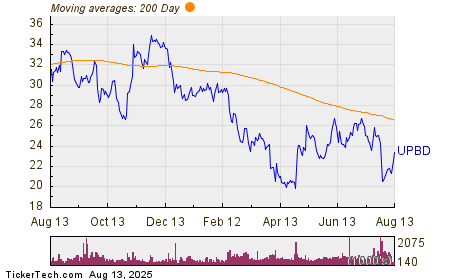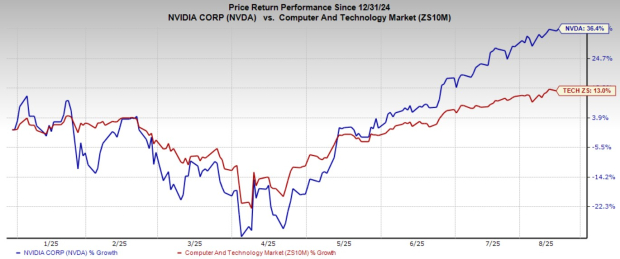The dollar index (DXY00) today is down -0.35%, adding to Tuesday’s loss of -0.43%. The dollar index has continued lower on increased expectations for Fed rate cuts through year-end. The dollar is also being undercut by weaker dollar interest rate differentials, with the 10-year T-note yield down -5.4 bp today and the 2-year T-note yield down by -5.6 bp.
Treasury Secretary Scott Bessent today said that interest rates are “too constrictive” and that rates “should probably be 150, 175 basis points lower.” He added, “There’s a very good chance of a 50 basis point cut. We could go into a series of rate cuts here, starting with a 50 basis point rate cut in September.” The Fed is currently targeting the federal funds rate in the range of 4.25%-4.50% and the effective rate is currently at 4.33%.
Join 200K+ Subscribers: find out why the midday Barchart Brief newsletter is a must-read for thousands daily.
The markets have started to think about the chances for a -50 basis point rate cut in September, based on Monday’s largely benign CPI report and the fact that the US labor market is slowing, with average monthly payroll growth in May-July of only +35,000. On a year-on-year basis, Tuesday’s July headline CPI of +2.7% y/y was slightly weaker than expected, but the core CPI of +3.1% y/y was slightly stronger than expected.
The federal funds futures market today boosted the odds to 100% for a -25 bp rate cut in September and a slight 1% chance of a -50 bp rate cut. The market late Tuesday was discounting the odds of a -25 bp rate cut in September at 96%, up from 40% before the July payroll report released on August 1. The federal funds futures market is currently discounting an overall -63 bp rate cut by the end of this year to 3.70%, and an overall -133 bp rate cut to 3.00% by the end of 2026.
In recent tariff news, President Trump extended the tariff truce with China, which was to expire on Tuesday, for another 90 days. Last Wednesday, President Trump announced that he will impose a 100% tariff on semiconductor imports. Still, companies would be eligible for exemptions if they demonstrate a commitment to building their products in the US. However, the US will levy a separate tax on imports of electronic products that employ semiconductors. also, Mr. Trump announced last Wednesday that he will double tariffs on US imports from India to 50% from the current 25% tariff, due to India’s purchases of Russian oil. Last Tuesday, Mr. Trump said that US tariffs on pharmaceutical imports would be announced “within the next week or so.” According to Bloomberg Economics, the average US tariff will rise to 15.2% if rates are implemented as announced, up from 13.3% earlier, and significantly higher than the 2.3% in 2024 before the tariffs were announced.
Federal funds futures prices are discounting the chances for a -25 bp rate cut at 100% at the September 16-17 FOMC meeting and at 70% for a second -25 bp rate cut at the following meeting on October 28-29.
EUR/USD (^EURUSD) is up +0.37% due to dollar weakness. However, sentiment on the euro remains cautious due to the negative impact of US tariffs on the European economy. also, market expectations are low for any significant progress at Friday’s Trump-Putin summit in Alaska regarding the Russia-Ukraine war.
Swaps are pricing in a 7% chance of a -25 bp rate cut by the ECB at the September 11 policy meeting.
USD/JPY (^USDJPY) is down -0.43% due to weakness in the dollar. The yen continues to be undercut by concern that US tariff policies will harm the Japanese economy.
December gold (GCZ25) is up +15.3 (+0.45%), and September silver (SIU25) is up +0.588 (+1.55%). Precious metals prices are higher today due to the weaker dollar and increased talk about US interest rate cuts through year-end. Precious metals are also seeing support from today’s decline in US T-note yields.
Gold continues to have safe-haven support related to US tariffs and geopolitical risks, including the conflicts in Ukraine and the Middle East. Fund buying of precious metals continues to support prices after gold holdings in ETFs rose to a two-year high on Monday, and silver holdings in ETFs reached a three-year high last Friday.
On the date of publication,
Rich Asplund
did not have (either directly or indirectly) positions in any of the securities mentioned in this article. All information and data in this article is solely for informational purposes.
For more information please view the Barchart Disclosure Policy
here.
The views and opinions expressed herein are the views and opinions of the author and do not necessarily reflect those of Nasdaq, Inc.






